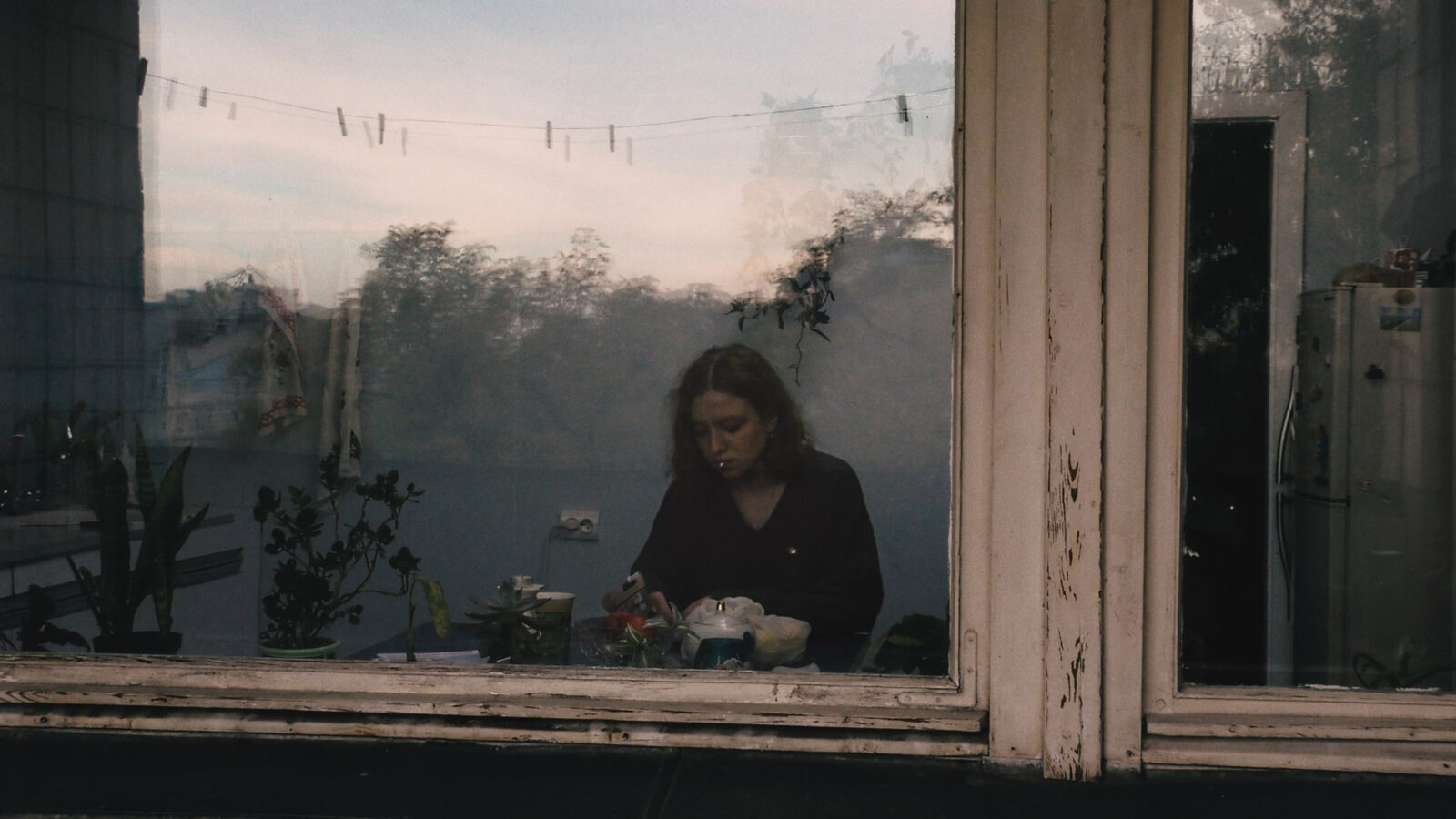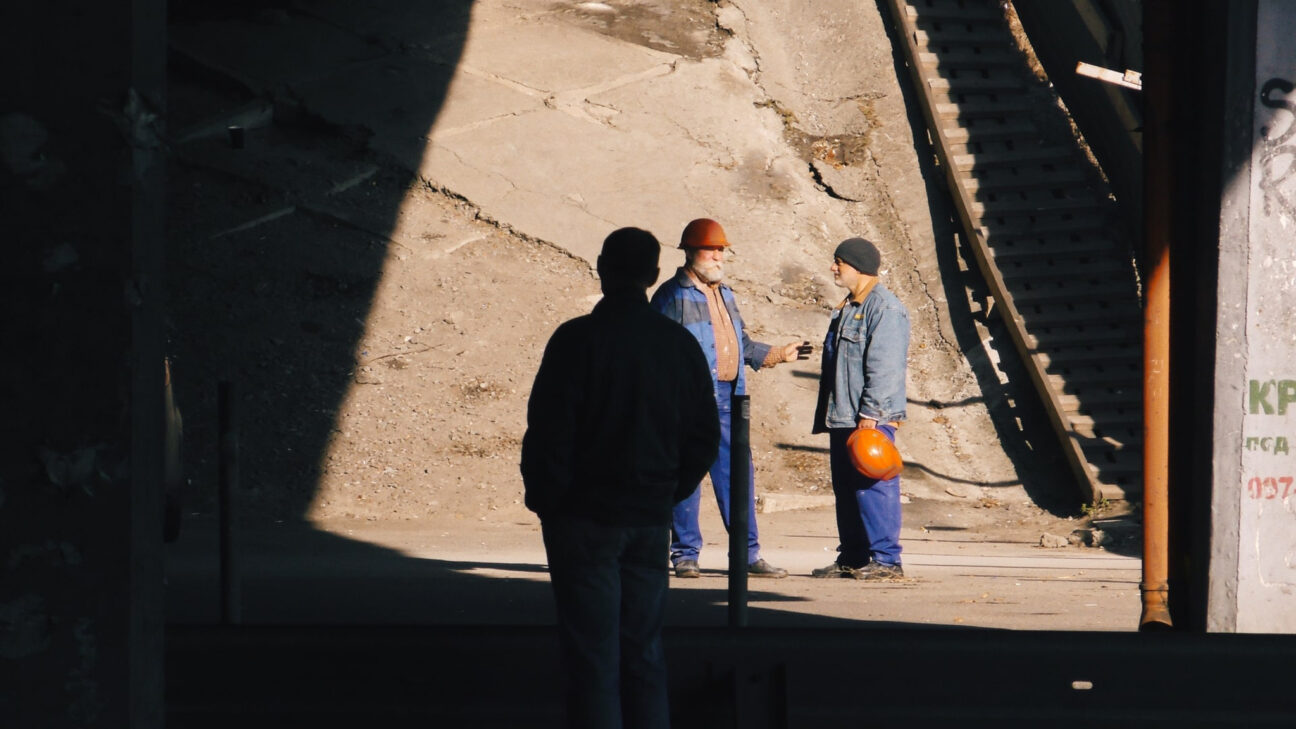Mental Fight
Interview with Vyacheslav Turyanytsya
Virginia Woolf’s famous essay “Thoughts on Peace in an Air Raid” finds new meaning in the film of the same name by Ukrainian director Vyacheslav Turyanytsya, as the skies of his country are torn by explosions. Resistance to aggression manifests itself in the urge to act and think, which is expressed both in the film’s plot and in its production.

“It is a queer experience, lying in the dark and listening to the zoom of a hornet, which may at any moment sting you to death,” wrote Virginia Woolf in her famous essay “Thoughts on Peace in an Air Raid”. While Woolf primarily criticises the patriarchal lust for wars, she also draws out the idea that resistance from a position of lesser power may be a mental fight, meaning “thinking against the current”. This idea, along with the essay’s title, has informed the new short by Ukrainian director Vyacheslav Turyanytsya, part of the International Competition at this year’s Filmfest Dresden.
His debut student short, Kharkiv Music Fest Did Happen (2022), was about a young volunteer who feels he’s not contributing enough action towards the victory. In Thoughts on Peace in an Air Raid, action inhabits a less heroic zeal, as the film tells stories of Kyiv citizens united by air raids: a construction worker taking a lunch break, a woman caring for her sick grandmother, and two men editing a film. In these observational shots, Turyanytsya concentrates on small actions as direct acts of resistance, concealing the mental fight Woolf wrote about.
That mental fight, as proposed by Woolf, also implied creativity, and this interpretation finds its place in the production of Turyanytsya’s film as well. Thoughts and many other shorts were largely made possible by the independent public organisation Contemporary Ukrainian Cinema (CUC). Founded by Valeria Sochyvets and Philip Sotnychenko as a supportive community, this April it celebrates ten years as an established platform that educates, mentors, produces, and distributes art that shapes the future of Ukrainian cinema.
Talking Shorts caught Turyanytsya in the midst of his research work—he’s pursuing a PhD in Film Studies—to talk about his passion for modernist literature, his film’s unintentional categorisation as a semi-documentary, and contemporary Ukrainian short film production.
What led you to Woolf’s essay, and how did it inspire your second film?
I love Anglo-American modernist literature, but with Woolf’s essay, everything happened accidentally. In the library of the Contemporary Ukrainian Cinema office, I came across a very small collection of her essays called Kinematograf. The collection itself is not original but was put together by a Russian publication. There’s not that much about cinema in it, but I was just struck by how incredibly thoughtful she was [writing] about cinema. Indeed, Woolf was a gifted person, but what truly impressed me was the way she wrote, often with greater depth and clarity than critics or scholars who focus solely on film.
To be honest, I wasn’t planning to film anything at that time. [Ukrainian director] Philip Sotnychenko observed me walking around with this book, and at some point he just gave me 1,000 euros and said, “Go ahead, I believe in you.” But I didn’t really have a coherent idea, and initially, I considered this film as a kind of training. I always imagined myself more on the side of analysing cinema than making it. That’s probably why I still can’t admit that I’m a filmmaker. I watch a lot of films, love cinema as a phenomenon, but I can’t say that I am obsessed with the production processes. But when I started reading this collection, a script was born in just a few days, almost unconsciously.
It’s interesting that this particular essay was included in a collection with a cinematic focus, because Woolf’s writing style itself carries distinctly cinematic qualities—her dramatic rhythm, the abstraction of collective imagery, and the way she composes them together. Would you say that Woolf’s writing style influenced the film more than the content of the essay itself?
Yes, absolutely. Although I have never taken seriously the idea that the essence of any literary work can be transferred to film. But the American modernists, in particular, feel super cinematic to me. William Faulkner’s The Sound and the Fury is a great example. His syllable is an unsurpassed mix of poetry, musicality, and cinematicity.
From Woolf, I wanted to draw the poetic nature of the writing, the concept of a certain abstraction without a clear dramatic arc. There may be traces of drama in my film, but there’s certainly no defined hero. So my aim was to capture a collective image of society, fragmented into a few seemingly random parts. I wondered what a random social cross-section might look like during wartime. And the first image of a social role that came to mind was included in the film.
Despite the abstraction of Thoughts, both Woolf’s essay and your film are full of action. Woolf uses an abundance of verbs, which heightens the emotional tone and supports her idea of thinking as an act of resistance. In your film, these verbs manifest through quiet routine actions, in which, I suppose, the process of thinking is embedded. How did you approach the implementation of these “verbs” within the mise-en-scène?
It’s hard to say that this was implemented consciously, but rather my usual filming model: long and durational shots. I was always looking for automatic actions and creating minimalist mise-en-scène out of them. You put the camera on—he eats, they talk, she cleans, and that’s it. Of course, the director of photography [Volodymyr Usyk] and I developed the camera’s choreography, where it would zoom in on action, but it was all done very instinctively. I can’t say that there’s a strict idea behind it.
I think that in the context of a full-scale war, thinking and performing some banal actions on automaticity is the minimum one can do. This has a lot in common with some examples of slow cinema, which are filled with silent actions with resistance hidden in them. Like Akerman’s protest against the patriarchal system… I’m hinting at Jean Dielman in your favourites on Letterboxd.
Yes! My main references were Lisandro Alonso and Chantal Akerman. I’m a big fan of slow cinema; it fascinates and frightens me simultaneously because something insignificant is always happening. There’s a kind of suspense, almost Hitchcockian in a way, in that you may not understand why almost nothing is happening, but you are anxiously anticipating it.
It’s like anywhere in Ukraine now—nothing seems to be happening, everything is chill, but maybe Hitchcock knows what will happen in two minutes. I mean, just 300 metres away from me now, there is the Okhmatdyt children’s hospital, which was bombed by the Russians last summer. This suspense is the main idea of the film: it’s about anxiety that is constantly present, but you still live here and do routine things.

Thoughts on Peace in an Air Raid (Vyacheslav Turyanytsya, 2024)
At one festival, I saw the film labelled as a documentary, and at another as a fiction. Who should we believe?
It’s a pretty confusing situation. It seems it was initially labelled as a documentary on some film portal. But I didn’t plan it as such—the film has a script and actors. At the same time, we shot some scenes in a documentary environment, and there were many spontaneous moments included.
Now we apply to different festivals, and they ask which section to send it to. Moreover, we have received invitations from documentary film festivals, which means that they have already defined it as a documentary on their own. And okay, let it be a hybrid film and let there be more opportunities to show it, God, I’m all for it. So now, for me, it’s a fiction film in a documentary style that the festival circuit has interpreted as a semi-documentary.
It seems that in contemporary Ukrainian cinema, where observational documentaries are at the forefront, their influence strongly shapes the rest of the industry.
And I will tell you even more—when the war started, I stopped watching fiction. It all seemed so artificial, because a real shitstorm is happening here and now. So I watched a lot of documentaries, and for almost a year, I couldn’t switch to fiction films at all.
I keep hearing the same thing from Ukrainian directors.
Given this collective alienation from fiction, and then the boom in documentary production, it changed everything. That’s why it’s very difficult to imagine contemporary Ukrainian fiction without documentary optics. There is still, to a certain extent, a director’s desire to capture reality. Even if you make a kind of genre film in space, the documentary optics are unavoidable.
And because the reality of a full-scale war cannot be forgotten during filming. Did the air raids affect your filming process in any way?
We shot the film in five days, but with air raids. Thank God, there was no heavy bombing of Kyiv at that time. In general, I can’t say that I’m one of those Ukrainians who just got used to air raids; for me, it’s still quite a trigger. I really didn’t want to have any moments of escalation during the filming. Eventually, the air raids were just enough to allow us to continue working, and at the same time to remind us of the reality.
I once interviewed your director of photography, Volodymyr Usyk, and he said that the Ukrainian film industry can be saved by the boom of shorts, as the production is simply faster and cheaper. Does it feel right from your perspective?
I started working after 2022, so it’s difficult for me to talk expertly. But I do know that a lot of short films are being made now, and this is evident at film festivals, both Ukrainian and foreign. I even know people whose careers have rocketed since the invasion began, because they started travelling and participating in cool co-productions. I don’t know if shorts will save the industry. Financially, it’s unlikely, but maybe mentally, yes.
This returns us to the shared idea in both Woolf’s essay and your film—that action and creativity are forms of resistance. In that sense, the very act of contemporary Ukrainian filmmaking is an expression of defiance in itself.
Absolutely. I don’t even know what to add. This is one of the stories that exists in the film—a guy sits and edits his film, despite the air raids. This is our act of resistance.
